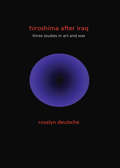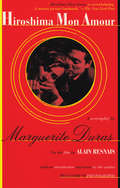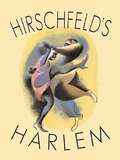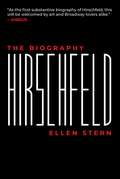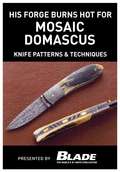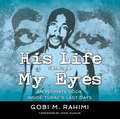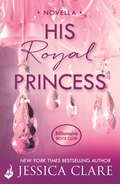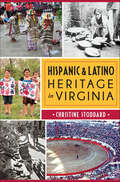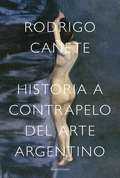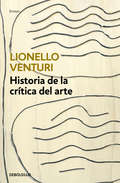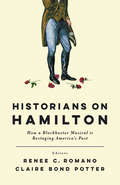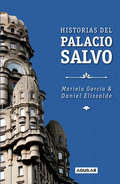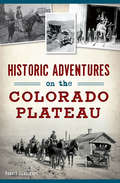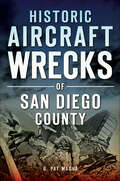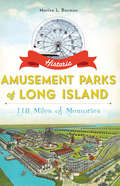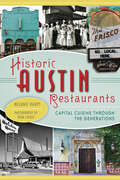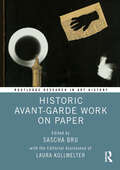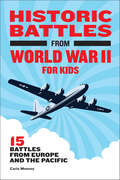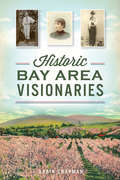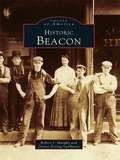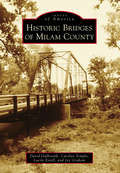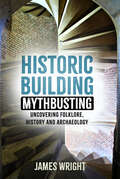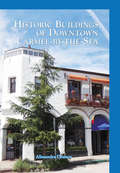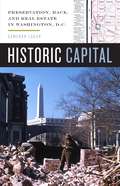- Table View
- List View
Hiroshima After Iraq: Three Studies in Art and War
by Rosalyn DeutscheMany on the left lament an apathy or amnesia toward recent acts of war. Particularly during the George W. Bush administration's invasion of Iraq, opposition to war seemed to lack the heat and potency of the 1960s and 1970s, giving the impression that passionate dissent was all but dead. Through an analysis of three politically engaged works of art, Rosalyn Deutsche argues against this melancholic attitude, confirming the power of contemporary art to criticize subjectivity as well as war. Deutsche selects three videos centered on the deployment of the atomic bomb: Krzysztof Wodiczko's Hiroshima Projection (1999), made after the first Gulf War; Silvia Kolbowski's After Hiroshima mon amour (2005-2008); and Leslie Thornton's Let Me Count the Ways (2004-2008), which followed the U.S. invasion of Iraq. Each of these works confronts the ethical task of addressing historical disaster, and each explores the intersection of past and present wars. These artworks profoundly contribute to the discourse of war resistance, illuminating the complex dynamics of viewing and interpretation. Deutsche employs feminist and psychoanalytic approaches in her study, questioning both the role of totalizing images in the production of warlike subjects and the fantasies that perpetuate, especially among the left, traditional notions of political dissent. She ultimately reveals the passive collusion between leftist critique and dominant discourse in which personal dimensions of war are denied.
Hiroshima After Iraq: Three Studies in Art and War (The Wellek Library Lectures)
by Rosalyn DeutscheMany on the left lament an apathy or amnesia toward recent acts of war. Particularly during the George W. Bush administration's invasion of Iraq, opposition to war seemed to lack the heat and potency of the 1960s and 1970s, giving the impression that passionate dissent was all but dead. Through an analysis of three politically engaged works of art, Rosalyn Deutsche argues against this melancholic attitude, confirming the power of contemporary art to criticize subjectivity as well as war. Deutsche selects three videos centered on the deployment of the atomic bomb: Krzysztof Wodiczko's Hiroshima Projection (1999), made after the first Gulf War; Silvia Kolbowski's After Hiroshima mon amour (2005-2008); and Leslie Thornton's Let Me Count the Ways (2004-2008), which followed the U.S. invasion of Iraq. Each of these works confronts the ethical task of addressing historical disaster, and each explores the intersection of past and present wars. These artworks profoundly contribute to the discourse of war resistance, illuminating the complex dynamics of viewing and interpretation. Deutsche employs feminist and psychoanalytic approaches in her study, questioning both the role of totalizing images in the production of warlike subjects and the fantasies that perpetuate, especially among the left, traditional notions of political dissent. She ultimately reveals the passive collusion between leftist critique and dominant discourse in which personal dimensions of war are denied.
Hiroshima Mon Amour: A Screenplay (Facile A Lire Ser. #No. 9)
by Marguerite DurasOne of the most influential works in the history of cinema, Alain Renais's Hiroshima Mon Amour gathered international acclaim upon its release in 1959 and was awarded the International Critics' Prize at the Cannes Film festival and the New York Film Critics' Award. Ostensibly the story of a love affair between a Japanese architect and a French actress visiting Japan to make a film on peace, Hiroshima Mon Amour is a stunning exploration of the influence of war on both Japanese and French culture and the conflict between love and inhumanity.
Hirschfeld's Harlem
by Al HirschfeldDecades before the PBS documentaries, before Bill Clinton, Al Hirschfeld went to Harlem and captured Harlem's dangerous highs and bluesy lows. Hirschfeld's Harlem opens a picture window into nearly a century of Black American artistry and life. Each drawing is accompanied by a thumbnail narrative by Hirschfeld about the most famous inhabitants and transients of the fabled streets.
Hirschfeld: The Biography
by Ellen SternThe definitive biography of Al Hirschfeld, renowned caricaturist and artist. Al Hirschfeld knew everybody and drew everybody. He occupied the twentieth century, and illustrated it. Hirschfeld: The Biography is the first portrait of the renowned artist's life—as spirited and unique as his pen-and-ink drawings. Beginning in the 1920s, he caricatured Hollywood actors, Washington politicians, and—his favorite—celebrities of the stage. Broadway belonged to Hirschfeld. His work appeared in the New York Times and other publications, as well as on book jackets, album covers, posters, and postage stamps, for more than seventy-five years. He lived in Paris, Moscow, and Bali, and in a pink New York townhouse on a star-studded block where his closest friends—Carol Channing, S. J. Perelman, Gloria Vanderbilt, Brooks Atkinson, Elia Kazan, Marlene Dietrich, and William Saroyan—flocked in and out. He played the piano, went to jazz joints with Eugene O'Neill, and wrote a musical that bombed. He drove until he was ninety-eight years old and always found a parking space. He worked every day, threw dinner parties twice a week, and hosted New Year's Eve soirees that were legendary. He had three wives, a formidable agent, and a daughter, Nina, the most famous little girl that no one knows. Hirschfeld died in 2003, at the age of ninety-nine. "If you live long enough," he liked to say, "everything happens." For him, it did. And good and bad—it's all here. Through interviews with Hirschfeld himself, his friends and family (including the mysterious Nina), and his famous subjects, as well as through letters, scrapbooks, and home movies, Ellen Stern has crafted a delightful, detailed, and definitive portrait of Al Hirschfeld, one of our most beloved, and most influential, artists.
His Forge Burns Hot for Mosaic Damascus: Knife Patterns & Techniques
by Joe KertzmanAmerican Bladesmith Society master smith Rick Dunkerley lights the mosaic-damascus fire, recommending steels and explaining the forge welding process, as well as steel stacking, pattern making, finishing and much more. Dunkerley includes diagrams and how-to sidebars on mosaic damascus patterns.
His Life Through My Eyes
by Gobi M. RahimiGobi M. Rahimi spent Tupac Shakur's last eight months with him, serving as a co-producer and director for many of his music videos and short films. Along the way, he took behind-the-scenes photographs of Tupac in more relaxed, casual settings. Gobi's photos and words show a side of Tupac that is rarely seen, and humanizes a man who has since become a legend.
His Royal Princess: A Billionaire Boys Club Novella (Billionaire Boys Club)
by Jessica ClareFans of J.S. Scott, Louise Bay and Melody Anne - prepare to be dazzled by Jessica Clare's Billionaire Boys Club.The Billionaire Boys Club is a secret society of six incredibly wealthy men who have vowed success in business - at any cost. But success when it comes to love is a different matter...Their romance led to a royal wedding in Once Upon a Billionaire. Now see how it all began for Princess Alexandra of Bellissime and American actor Luke Houston.As heir to the throne of Bellissime, Princess Alexandra is supposed to be cool and calm...not crushing on a movie star. When she hears that Luke Houston is filming a scene for his next movie in her tiny country, however, she can't resist sneaking onto set to get a glimpse of the Hollywood hunk. When Alex is almost caught on set by the press, she ducks into the first available hiding place - only to find herself in Luke's private trailer, and getting much more than just a glimpse of him. It's an up close and personal encounter that sets her heart aflutter, and sets her mind on some very unladylike plans to get to know him better...Want more irresistible romance? Look for the rest of the Billionaire Boys Club titles, starting with Stranded With A Billionaire, as well as the sizzling spinoff series, Billionaires and Bridesmaids, starting with The Billionaire And The Virgin.
Hispanic & Latino Heritage in Virginia (American Heritage)
by Christine StoddardLong before the adventures of John Rolfe and Pocahontas, Spanish ships reached Virginia's shore. In the centuries that followed, Hispanics and Latinos settled in Virginia to seek new opportunities away from home. The 1980s saw the beginnings of el Nuevo Sur, or the New South, as Virginia's Latin American population surged. Since then, the now-defunct Virginia Center for Latin American Art briefly showcased Virginia's Latino and Hispanic evolving arts heritage. Restaurants like Pollo Campero and La Tasca have joined the local culinary scene, and schools and churches have forged plans for their changing communities. Join author Christine Stoddard as she traces the vibrant history and culture of Hispanics and Latinos in Virginia.
Historia a contrapelo del arte argentino
by Rodrigo CañeteContranarrativa del arte argentino que lee su historia desde la perspectiva de los traumas nacionales que encontraron expresión en su producción estética, en particular, visual. Reflexivo, crítico y polémico, Cañete desempolva el museo de la patria y sacude su panteón. Este libro presenta una historia del arte argentino construida a partir de una mirada ética y estéticamente crítica. Su punto de partida es la pregunta sobre la existencia misma de su objeto; su propósito, promover y vigorizar un debate necesariamente reflexivo, argumentado y, por definición, político. En ese gesto, Rodrigo Cañete se propone, además de poner en discusión el canon artístico nacional, sacar a los artistas de los panteones históricos y contemporáneos en los que instituciones y élites los han ido confinando, y desempolvar el museo de la patria para enfrentar los fantasmas que en última instancia acechan a la Argentina como país signado por la exclusión, el racismo y la veneración por lo extranjero. Largamente esperada, intelectualmente desafiante e inevitablemente polémica, Historia a contrapelo del arte argentino es también un repertorio de recursos para que sus lectores se abran paso en esos "circuitos" de la producción estética que con frecuencia se presentan como públicos al tiempo que se comportan refractarios, laberínticos y endogámicamente blindados.
Historia de la crítica del arte
by Lionello VenturiEl ensayo más célebre de uno de los intelectuales y pensadores más decisivos de la historia del arte contemporánea. Las páginas del presente libro abarcan un vastísimo período que va de la era clásica a la contemporánea. Sin limitarse únicamente a señalar y comentar textos pertenecientes explícitamente a la denominada literatura artística, esta rica y amplia investigación ofrece una pormenorizada historia de las ideas, de las teorías, de las apreciaciones, de la toma de posición que atañe al arte figurativo desde hace siglos. La actitud de los críticos, de los pensadores, de los artistas es analizada con la intención de destacar el curso cambiante de las reflexiones sobre el arte y hacer emerger sus momentos cruciales, restituyendo así la condición misma del arte a lo largo de la historia. Reseña:«El gran Lionello Venturi, en Historia de la crítica del arte, lamentaba la dicotomía planteada, en el mundo moderno, entre historia y crítica de arte. Tal conflicto, años después de su advertencia, continúa vigente.»Francisco Calvo Serraller, El País
Historians on Hamilton: How a Blockbuster Musical Is Restaging America's Past
by William Hogeland Elizabeth L. Wollman Jeffrey L. Pasley Michael O'Malley Jim Cullen David Waldstreicher Catherine Allgor Renee C. Romano Andrew M. Schocket Brian Eugenio Herrera Joanne B. Freeman Claire Bond Potter Lyra D. Monteiro Leslie M. Harris Joseph M. Adelman Patricia HerreraAmerica has gone Hamilton crazy. Lin-Manuel Miranda’s Tony-winning musical has spawned sold-out performances, a triple platinum cast album, and a score so catchy that it is being used to teach U.S. history in classrooms across the country. But just how historically accurate is Hamilton? And how is the show itself making history?Historians on Hamilton brings together a collection of top scholars to explain the Hamilton phenomenon and explore what it might mean for our understanding of America’s history. The contributors examine what the musical got right, what it got wrong, and why it matters. Does Hamilton’s hip-hop take on the Founding Fathers misrepresent our nation’s past, or does it offer a bold positive vision for our nation’s future? Can a musical so unabashedly contemporary and deliberately anachronistic still communicate historical truths about American culture and politics? And is Hamilton as revolutionary as its creators and many commentators claim? Perfect for students, teachers, theatre fans, hip-hop heads, and history buffs alike, these short and lively essays examine why Hamilton became an Obama-era sensation and consider its continued relevance in the age of Trump. Whether you are a fan or a skeptic, you will come away from this collection with a new appreciation for the meaning and importance of the Hamilton phenomenon.
Historias del Palacio Salvo
by Daniel Elissalde Mariela GarcíaEn este libro, a través de sus investigaciones y de su pasión, los autores nos invitan a recorrerlo para descubrir su historia y las historias que, en sus entrañas, se tejieron a lo largo del tiempo. El Palacio Salvo es una silueta que identifica a Montevideo, un símbolo de hormigón y hueso. Es Historia y presente. En él hay memorias y misterios, pasillos silenciados, pinturas escondidas en sus entrepisos, acordes de La cumparsita, ecos de grandes bailes en sus soberbios salones, historias latentes en sus recovecos, arquitectura simbólica, arte y, también, vida cotidiana de los habitantes pasados y presentes. Lo vemos a diario, pero no hay mirada que pueda abarcar todo lo que muestra o sugiere.
Historic Adventures on the Colorado Plateau (Transportation)
by Bob SilbernagelThe Colorado Plateau is home to nearly thirty national parks, monuments and recreational areas. The unique geology, stunning rock formations, powerful rivers and numerous scenic canyons that compose such a striking region also made navigation difficult. Yet daring explorers braved the journey. Rock art and other artifacts are evidence of occupation thousands of years ago. Spanish explorers once trekked across this rugged terrain, seeking information on the native populace, religious converts and trade routes. In the frontier era, a trio of bandits discovered the value of good horses while fleeing for three hundred miles. Nearly a century after the gold rush, uranium fever brought another boom to the rugged reaches of the area in the 1940s. Supported by years of research, Bob Silbernagel traces the Colorado Plateau's intrepid inhabitants throughout history.
Historic Aircraft Wrecks of San Diego County (Disaster)
by G. Pat MachaClear weather and a natural harbor made San Diego an early aviation hub, but success in flight came with devastating tragedies. The remains of more than four hundred aircrafts lie scattered across the county's deserts and mountains. Experts estimate that dozens more are on the ocean floor off the coast. In 1922, army pilot Charles F. Webber's DeHavilland biplane went missing over Cuyamaca Rancho State Park. In 1978, Pacific Southwest Airlines Flight 178 collided midair over San Diego and crashed in the residential North Park neighborhood, claiming the lives of 144 people in what was the worst airline disaster of the era. Author and aircraft accident research specialist G. Pat Macha recounts these and other stories of astonishing survival, heroism and heartbreaking fatality.
Historic Amusement Parks of Long Island: 118 Miles of Memories
by Marisa L. BermanWhen Long Island became a suburban paradise after World War II, ambitious entrepreneurs created dozens of amusement parks to help families unwind. The Nunley family built a park in Baldwin in 1939, and it was so successful that they opened Nunley's Happyland in Bethpage just a few years later. Westbury's Spaceland fascinated youngsters with dreams of becoming astronauts, and Frontier City in Amityville was heaven on earth to fans of the Wild West. Today, historic parks like Deno's Wonder Wheel Park in Coney Island and Adventureland in Farmingdale still delight children and remind parents of happy memories of their own. Local author Marisa Berman explores the decades of fun and laughter from Long Island's historic amusement parks.
Historic Austin Restaurants: Capital Cuisine through the Generations (American Palate)
by Melanie HauptAustin has staked its claim as the seat of innovative culinary movements, and its food culture mirrors the transformations taking place across the city. The evolution of the east side is reflected in joints like Franklin Barbecue, while landmarks like Scholz Garten, the oldest restaurant in the capital, testify to the contributions of the town's college presence and a healthy German influence. Joe's Bakery isn't just one of the town's most beloved Tex-Mex spots; it's the place where the real wheeling and dealing in Texas politics happens. Food writer Melanie Haupt samples Austin's iconic restaurants and the rich heritage that produced them.
Historic Avant-Garde Work on Paper (Routledge Research in Art History)
by Sascha Bru Laura KollwelterThis book examines the many functions of paper in the fine art and aesthetics of the early twentieth-century modernist or historic avant-garde (Expressionism, Cubism, Futurism, Dadaism, Surrealism, Constructivism and many more).With its many collages and photomontages, the historic avant-garde is generally considered to have transformed paper from a mere support into an artistic medium and to have assisted in art on paper gaining a firm autonomy. Bringing together an international team of scholars, this book shows that the story of paper in the avant-garde has thereby hardly been told. The first section looks at a selection of canonized individual avant-gardists’ work on paper to demonstrate that the material and formal analysis of paper in the avant-garde’s artistic production still holds much in store. In the second section, chapters zoom in on forms and formats of collective artistic production that deployed paper to move around reproductions of fine art works, to facilitate the dialogue between avant-gardists, to better promote their work among patrons, and to make their work available to a wider audience. Chapters in the third section lay bare how certain groups within the avant-garde began to massively create monochrome works, because these could be easily reproduced when transferred to, or reproduced as, linocuts. In the last section of the book, chapters explore how the avant-garde’s attentiveness to paper almost always also implied a critique of the ways in which paper, and all that it stood for, was treated and labored in European culture and society more broadly.The book will be of interest to scholars working in art history, modernism, and design.
Historic Battles from World War II for Kids: 15 Battles from Europe and the Pacific (Historic Battles for Kids)
by Carla MooneyAn up-close look at the battles of World War II for kids ages 8 to 12Help kids learn all about World War II—right from the front lines. This fascinating guide focuses on the battles that decided the outcome of the war. Each entry puts kids directly in the general's seat, walking them through the flow of battle as well as the strategies, tactics, and technology that made the difference between victory and defeat.Go beyond other World War 2 books for kids with:15 key conflicts—Kids will dive deep into well-known and lesser-explored battles alike, from the Attack on Pearl Harbor to the Battle of Crete.Battlefield basics—Each chapter starts off a quick breakdown of the battle, including dates, objectives, and what was at stake.Closer looks—Young learners will find out even more with the help of technological explorations, battle maps, by-the-numbers sidebars, and more.Give kids an exciting new perspective on World War 2 history!
Historic Bay Area Visionaries (American Chronicles)
by Robin ChapmanFor centuries, California's environment has nurtured remarkable people. Ohlone Lope Inigo found a way to protect his family in troubled times on the shores of San Francisco Bay. Pioneer Juana Briones made a fortune from her rancho yet took the time to care for those in need. Innovator Thomas Foon Chew discovered a climate for success, in spite of the obstacles. Around the region that became Silicon Valley, filmmaker Charlie Chaplin found inspiration, poet Robert Louis Stevenson uncovered adventure and Sarah Winchester built a house that would intrigue people long after she was gone. Author Robin Chapman shares fascinating tales of those who exemplify the enterprising spirit of the Golden State.
Historic Beacon (Images of America)
by Denise Doring Vanburen Robert J. MurphyResidents of Beacon, New York, are justifiably proud of a community that is rich in history and promise. In this exquisite collection of images, local historians Robert J. Murphy and Denise Doring VanBuren uncover the fascinating past of Beacon andthe people who have called it home. The community's earliest permanent European settler was Madam Catheryna Rombout Brett, whose c. 1709 home is preserved within the city as the the oldest building in Dutchess County. Within the vicinity of the Madam Brett Homestead, two distinct villages grew: Matteawan, a manufacturing community at the foot of the mountain, and Fishkill Landing, a Hudson River port. Both villages prospered and eventually merged in 1913. Through the decades, the community was hailed as a model of a successful manufacturing center and became the location for several significant Hudson River estates. It played host to one of the longestrunning ferries in American history and introduced one of the first electric streetcar systems in the Hudson River Valley. Perhaps its most well-known feature was the Mount Beacon Incline Railway, a feat of engineering documented as the world's steepest incline railroad.
Historic Bridges of Milam County (Images of America)
by Lucile Estell Carolyn Temple David Galbreath Joy GrahamMilam County, located in the heart of Central Texas, is home to 18 historic bridges that were constructed through the years to accommodate the growth of the county. One bridge, Worley Bridge, has been fully restored in a cooperative effort between Milam County and the Texas Department of Transportation (TXDOT). TXDOT is an important partner in the preservation of these historic structures. Memories of some bridges will be preserved in a bridge park, which is being constructed in Rockdale. Other bridges simply stand in mute testimony to the passing of time and the changing of human needs and habits. This book tells the story of these bridges and their important role in our history. It provides knowledge and understanding of these structures.
Historic Building Mythbusting: Uncovering Folklore, History and Archaeology
by James Wright'Funny, occasionally filthy and ultimately fascinating.' - Richard Herring, comedianGo to any ancient building in the land and there will be interesting and exciting stories presented to the visitor. Tales of secret passages and hidden tunnels, strange marks and carvings left by stonemasons – all commonly believed and widely repeated, but are they really true?From ship timbers being repurposed on dry land to spiral staircases giving advantage to right-handed defenders, and from archers sharpening their arrows on church stones to claims of being the oldest pub in the country, Historic Building Mythbusting seeks to uncover the real stories.Buildings archaeologist James Wright explains and unpicks the development of these myths and investigates the underlying truths behind them. Sometimes the realities hiding behind the stories are even more engaging, romantic and compelling than the myths themselves...
Historic Buildings of Downtown Carmel-by-the-Sea
by Alissandra DramovCarmel-by-the-Sea was established in the early 1900s and has been described as a quaint, European-like village among the trees along Central California's coast. The architectural styles that shaped the downtown character emerged predominantly in the 1920s and 1930s and were mostly Northern and Southern European-influenced Romantic Revival styles. The Court of the Golden Bough features Tudor Revival-style buildings, with medieval influence, while many of the larger buildings and hotels downtown are in the Mediterranean and Spanish Revival styles. Fairy-tale storybook designs add to the town's one-of-a-kind charm. A few Western false-front and Craftsman-style buildings from the start of the 20th century, some post-World War II modernist works in the Second and Third Bay Region styles, and ones inspired by Frank Lloyd Wright's organic architecture all add to the eclectic mix. Carmel-by-the-Sea has emphasized walking and the outdoors, with its courtyards and passageways, parks, gardens, and landscaping. Take a journey and discover the historic buildings that make up the downtown of this unique seaside town.
Historic Capital: Preservation, Race, and Real Estate in Washington, D.C.
by Cameron LoganWashington, D.C. has long been known as a frustrating and sometimes confusing city for its residents to call home. The monumental core of federal office buildings, museums, and the National Mall dominates the city&’s surrounding neighborhoods and urban fabric. For much of the postwar era, Washingtonians battled to make the city their own, fighting the federal government over the basic question of home rule, the right of the city&’s residents to govern their local affairs. In Historic Capital, urban historian Cameron Logan examines how the historic preservation movement played an integral role in Washingtonians&’ claiming the city as their own. Going back to the earliest days of the local historic preservation movement in the 1920s, Logan shows how Washington, D.C.&’s historic buildings and neighborhoods have been a site of contestation between local interests and the expansion of the federal government&’s footprint. He carefully analyzes the long history of fights over the right to name and define historic districts in Georgetown, Dupont Circle, and Capitol Hill and documents a series of high-profile conflicts surrounding the fate of Lafayette Square, Rhodes Tavern, and Capitol Park, SW before discussing D.C. today.Diving deep into the racial fault lines of D.C., Historic Capital also explores how the historic preservation movement affected poor and African American residents in Anacostia and the U Street and Shaw neighborhoods and changed the social and cultural fabric of the nation&’s capital. Broadening his inquiry to the United States as a whole, Logan ultimately makes the provocative and compelling case that historic preservation has had as great an impact on the physical fabric of U.S. cities as any other private or public sector initiative in the twentieth century.
